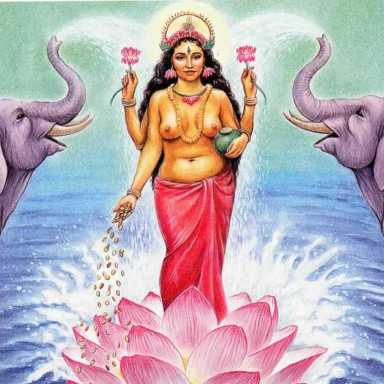“Boldogasszony’s themes are winter, love, romance, relationships, devotion, purity and fertility. Her symbol is milk. This Hungarian mother and guardian Goddess watches diligently over Her children, wanting only the best for them, as any mother would. Her sacred beverage, milk, is also considered a suitable libation when asking for this Goddess’s blessing.
Hungarian wedding festivals often take place in winter, after the harvest season and meat preparation. The traditions here are laden with magic we can ‘borrow’ for building strong personal relationships, asking for Boldogasszony’s blessing by having a cup of milk present at any activity. For example, cutting a rope that is attached to your home symbolizes your release from the old ways and freedom to enter into commitment. Stepping across birch wood purifies intentions and ensures a fertile, happy union.
Lighting a torch (or candle) represent vigilant devotion in a relationship. Do this at the time of your engagement, as you recite vows, or as you both enter a new residence for the first time so that commitment will stay with you. Wherever you are, eating off each other’s plates and drinking from one cup deepens harmony (include a milk product like cheese). Finally, dancing with kitchen utensils ensures that the home fire will always stay warm.”
(Patricia Telesco, “365 Goddess: a daily guide to the magic and inspiration of the goddess”.)
According to the Wikipedia, Boldogasszony was a mother Goddess. “Her name means ‘Blessed Lady’ or ‘Bountiful Queen’. She was the Goddess of motherhood and helped women in childbirth. After Hungarians were Christianized with the help of St. Gerard of Csanad, Her figure fell out of favor for that of the Virgin Mary. She is also considered the ‘Queen (Regina) of Hungary'”. [1]
I pretty much found the same information on Britannica.com: “Boldogasszony, also called Nagyboldogasszony, the Hungarian equivalent of the Beata Virgo (Latin: ‘Blessed Virgin’), referring to the Virgin Mary as the patron saint of the Hungarian nation. Originally, Boldogasszony was probably one of the main deities of pagan Magyar mythology. The name was transferred to the Virgin Mary on the advice of St. Gerard of Csanad (Gerard Sagredo), one of the chief Christian evangelizers of Hungary.
Stephen I, the first Hungarian king (997–1038), offered his country to Mary as the patroness of the Hungarians (Magyarok Nagyasszonya) at the end of his reign. As a consequence, the country was often referred to as Mary’s realm, the Regnum Marianum. On the occasion of the country’s millennial celebrations (1896), Pope Leo XIII sent an encyclical letter to the Hungarian nation, granting permission for Hungarian Catholics to celebrate the feast of the patroness Boldogasszony.” [2]
According to the Encyclopedia of Spirits: “Boldog Asszony literally means ‘Happy Woman.’ Asszony, translated as ‘woman,’ possesses an extra nuance: Asszony indicates a relationship so close and intimate that, though not a physical blood relative, it is impossible to conceive of having a wedding or funeral without Her. That’s the gist of Boldog Asszony, presiding spirit of life cycles, especially births and weddings.
Boldog Asszony grants fertility, oversees pregnancy, and supervises birth. It is traditional to honor Her immediately after birth. An offering table is laid to Her, and She must be formally thanked. She is, as Her title indicates, a generally benevolent, patient Goddess not given to the temper tantrums displayed by some Birth Fairies. If a family fails to honor Her, it may take years for Her displeasure to manifest: fail to thank Boldog Asszony at the birth of a baby, and that baby may never have a happy marriage. (The opportunity exists in the years in between to apologize and make amends.)
Boldog Asszony is a title, not a name, and it is now generally applied to the Virgin Mary, but the original Boldog Asszony was a Goddess with dominion over joy, fertility, and abundance, among the primary deities of the Hungarian pantheon. Saint Gellert, who converted the Hungarians to Christianity in the eleventh century, wrote that the Church was associating Boldog Asszony with Mary and calling Her the Queen of Hungary.
Boldog Asszony has seven daughters who bring good fortune. To differentiate Her from Her daughters, She is called Nagy Boldogaszony (‘Big or Great Boldog Asszony’) while Her daughters are Kis Boldogaszony (‘Little Boldog Asszony’). She is intensely identified with Mary. Alternatively, She is identified with Saint Anne, while Little Boldog Asszony, reduced to one daughter, is identified with Anne’s daughter, Mary.
Day: Tuesday. (Do not do laundry or anything that pollutes or dirties water on Her day).
Sacred day: She is now associated with Christmas and with various harvest festivals throughout the year.
Offerings: Water, wine, pastries, dried and fresh fruit, Palinka (Hungarian fruit brandy).
See also: Atete; Black Madonna; Fairy, Birth; Szépasszony” (Illes, p. 292 – 293).
In this video, Zsuzsanna Budapest tells her story with her experience with Boldogasszy during WWII and the Hungarian Revolution.
Sources:
Britannica.com, “Boldogasszony“.
Illes, Juika. Encyclopedia of Spirits, “Boldog Asszony“.
Wikipedia, “Magyar mythology“.
Suggested Links:
Content.yudu.com (Goddess Magazine – August 2009), “Boldogasszony – Glad Woman” (p. 14- 17).
Goddesses-and-gods.blogspot.com, “Goddess Boldogasszony“.
Hamori, Fred. Users.cwnet.com, “The Sumerian and Hungarian Fertility Goddess“.
Holland, Ellen. Holland’s Grimoire of Magickal Correspondences: A Ritual Handbook.
Infinite8design.com, “Goddesses of Hungary“.
Zbudapest.com, “The Goddess/Wiccan Movement: Interview with Z Budapest“.

















































